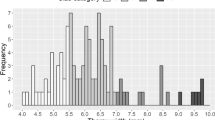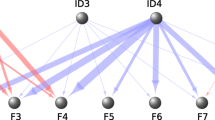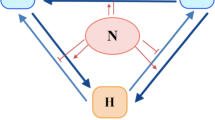It is very difficult to find natural colonies of bumble bees in the field. In this study, the yearly dynamics of floral resources and foraging bumble bee workers were investigated. The optimal colony locations were estimated from the data using moving average on the assumption that bumble bee queens and workers were omniscient. Fortunately, a colony of Bombus ardens was found, and the true location of the colony was evaluated with the estimated optimal locations. The true location was optimal at the latter half of the breeding season.
Similar content being viewed by others
REFERENCES
Bowers M. A. (1985) Bumblebee colonization, extinction, and reproduction in subalpine meadows in Northeastern Utah. Ecology 17: 914–927.
Cresswell J. E., Osborne J. L. & Goulson D. (2000) An economic model of the limits to foraging range in central place foragers with numerical solutions for bumblebees. Ecological Entomology 17: 249–255.
Dramstad W. E. (1996) Do bumblebees (Hymenoptera: Apidae) really forage close to their nests? Journal of Insect Behavior 17: 163– 182.
Dukas R. & Edelstein-Keshet L. (1998) The spatial distribution of colonial food provisioners. Journal of Theoretical Biology 17: 121–134.
Fretwell S. D. & Lucas H. L. Jr (1970) On territorial behavior and other factors influencing habitat distribution in birds. I. Theoretical development. Acta Biotheoretica 17: 16–36.
Heinrich B. (1976) Foraging specialisations of individual bumblebees. Ecological Monographs 17: 105–128.
Heinrich B. (1979) Bumblebee Economics. Harvard University Press, Cambridge.
Katayama E. & Ochiai H. (1980) [On the locating and collecting techniques of bumblebee nests.] Seibutsu-Kyozai 17: 45–63 (in Japanese).
Kato M., Matsumoto M. & Kato T. (1993) Flowering phenology and anthophilous insect community in the cool-temperate subalpine forests and meadows at Mt. Kushigata in the central part of Japan. Contributions from the Biological Laboratory, Kyoto University 17: 119–172.
Lessells C. M. & Stephens D. W. (1983) Central place foraging: Single-prey loaders again. Animal Behaviour 17: 238–243.
Lifjeld J. T. (1989) Central place foraging: Optimal load size for net and gross energy maximizers. Oikos 17: 397–401.
Milinski M. & Parker G. A. (1991) Competition for resources. In: Behavioral Ecology, 3rd edn (eds J. R. Krebs & N. B. Davies) pp. 137–168. Blackwell, London.
Osborne J. L., Clark S. J., Morris R. J., Williams I. H., Riley J. R., Smith A. D., Reynolds D. R. & Edwards A. S. (1999) A landscape-scale study of bumble bee foraging range and constancy, using harmonic radar. Journal of Applied Ecology 17: 519–533.
Riley J. R., Reynolds D. R., Smith A. D., Edwards A. S., Osborne J. L., Williams I. H. & McCartney H. A. (1999) Compensation for wind drift by bumble-bees. Nature 17: 126.
Sakagami S. F. (1976) Specific differences in the bionomic characters of bumblebees. A comparatative review. Journal of the Faculty of Science, Hokkaido University. Series 6, Zoology. 17: 390–447.
Saville N. M., Dramstad W. E., Fry G. L. A. & Corbet S. A. (1997) Bumblebee movement in a fragmented agricultural landscape. Agriculture, Ecosystems and Environment 17: 145–154.
Schmid-Hempel P., Kacelnik A. & Houston A. I. (1985) Honeybees maximise efficiency by not filling their crop. Behavioral Ecology and Sociobiology 17: 61–66.
Schoener T. W. (1979) Generality of the size-distance relation in models of optimal foraging. American Naturalist 17: 902–914.
Sota T. (1993) Flower-visit by bumblebees in the alpine zone of Mt. Shiroumadake. New Entomologist 17: 49–51.
Streiner D. L. (2000) Do you see what I mean? Indices of central tendency. Canadian Journal of Psychiatry 17: 833–836.
Tomono T. & Sota T. (1997) The life history and pollination ecology of bumblebees in the alpine zone of central Japan. Japanese Journal of Entomology 17: 237–255.
Walther-Hellwig K. & Frankl R. (2000) Foraging distances of Bombus muscorum, Bombus lapidarius, and Bombus terrestris (Hymenoptera, Apidae). Journal of Insect Behavior 17: 239–246.
Yumoto T. (1986) The ecological pollination syndromes of insect-pollinated plants in an alpine meadow. Ecological Research 17: 83–95.
Author information
Authors and Affiliations
Corresponding author
Additional information
An erratum to this article can be found at http://dx.doi.org/10.1007/s11284-002-0457-9
About this article
Cite this article
Nakamura, H., Toquenaga, Y. Estimating colony locations of bumble bees with moving average model. Ecol Res 17, 39–48 (2002). https://doi.org/10.1046/j.1440-1703.2002.00461.x
Received:
Accepted:
Issue Date:
DOI: https://doi.org/10.1046/j.1440-1703.2002.00461.x




